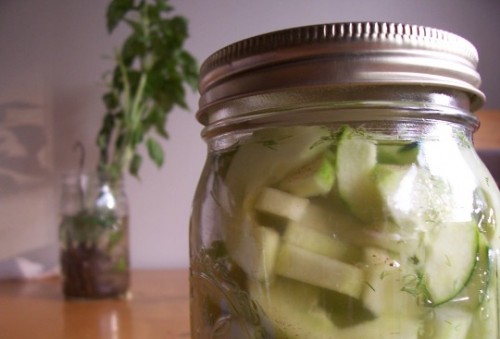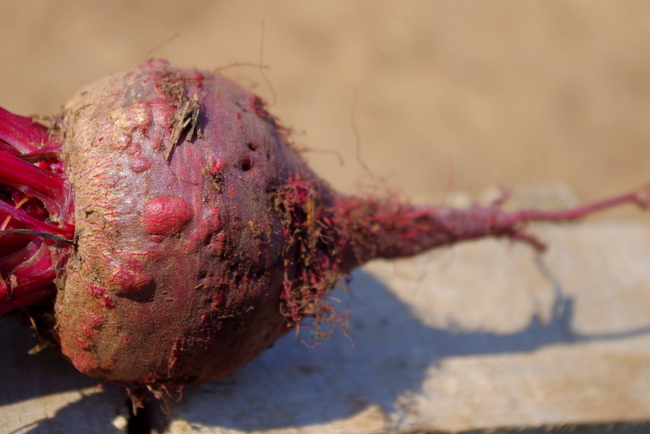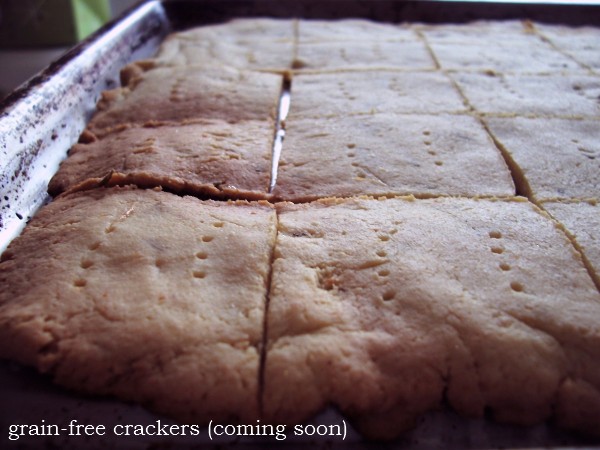Fermented Food for Beginners: Lacto-Fermented Vegetables

This is part 3 in a four part series. I renamed this series Fermented Food for Beginners in the hopes that it will encourage anyone who was intimidated about making their own ferments, as I was.
- Part 1: Introduction
- Part 2: Fermented Dairy
Before the advent of modern day canning most of our American fore mothers understood the process of lacto-fermentation. They had crocks of real sauerkraut, lacto-fermented cucumber pickles and other treasures such as beets, onions or garlic waiting out the winter in the root cellar.
Those countries with histories deeper than our own also traditionally fermented vegetables with simply salt, water and spices – knowing that the lactic acid produced would prevent the putrefication of these precious nutritional storehouses, keeping them fed through winter. Kimchi from Korea and cortido from Latin America are just two of the flavorful and delicious condiments not native to our own country.
When we lost touch with this food preservation technique we also lost touch with the unparalleled health benefits that came with them. Sally Fallon is a huge proponent of lacto-fermentation in her book Nourishing Traditions, and for good reason:
The proliferation of lactobacilli in fermented vegetables enhances their digestibility and increases vitamin levels. These beneficial organisms produce numerous helpful enzymes as well as antibiotic and anti carcinogenic substances. Their main by-product, lactic acid, not only keeps vegetables and fruits in a state of perfect preservation but also promotes the growth of healthy flora throughout the intestine.
After being completely overwhelmed by my first read through of Nourishing Traditions I waited months before making sauerkraut. The concept was foreign and intimidated me. Because I have grown up in a culture that thinks you have to pasteurize everything I wondered if I would poison my family.
If you are like I was – intimidated and a bit doubtful – then don’t be. You will know if a batch has gone bad. You will get used to, and even start to enjoy, the flavor of these healthful condiments. You will find that they are not much more difficult to assemble than a simple salad. You will actually want to keep a few jars/crocks on hand for health and flavor reasons.
To be honest I wasn’t wild about sauerkraut at first, nor the pickles that turned to mush. I found that I enjoyed bolder variations of sauerkraut such as kimchi and cortido. I also recently discovered how to make pickles keep their crunch a bit more – grape leaves. I’ve only tried one batch, adding the wild grape leaves from our own backyard, but they are crunchy and delicious instead of mushy and off-putting like my first few batches. It is the tannins in the grape leaves that are said to perform the delicious act.
So I would encourage you, if you were like me, to give lacto-fermentation a try. It is fairly simple, frugal and makes the most of your hard-earned real food. You can use whey as a starter culture in your brine, which Sally Fallon recommends in Nourishing Traditions.
I have not been using whey as of late and have yet to have a bad batch. I will leave you with two of my favorite flavors of lacto-fermented vegetables – cortido and dill pickles. I have come to love these little treasures so much that it makes it easy to eat them at two meals a day. Now all I need is that root cellar I dream of so that I can stock it full of giant crocks full of these tasty treasures.
Cortido
from Nourishing Traditions by Sally Fallon Recipe Notes: I sometimes leave out the carrots and halve the amount of onions. A struggle that I have is keeping the vegetables below the liquid level. I have yet to have a bad batch, but this can cause mold. One thing that I am considering purchasing from here is an airlock setup that allows the fermentation gases to escape while keeping air out. You can also purchase ready-made lacto-fermented vegetables here.
- 1 large cabbage, cored and shredded
- 1 cup carrots, grated
- 2 medium onions, quartered lengthwise and very finely sliced
- 1 tablesoon dried oregano
- 1/4 – 1/2 teaspoon red pepper flakes
- 1 tablespoon sea salt
- 4 tablespoons whey (if not available, use an additional 1 tablespoon salt)
- In a large bowl mix cabbage with carrots, onions, oregano, red chile flakes, sea salt and whey.
- Pound with a wooden pounder or a meat hammer for abou 10 minutes to release juices.
- Place in 2 quart-sized, wide mouth mason jars and press down firmly with a pounder or meat hammer until juices come to the top of the cabbage. The top of the cabbage mixture should be at least 1 inch below the top of the jars.
- Cover tightly and keep at room temperature for about 3 days before transferring to cold storage.
Pickled Cucumbers
from Nourishing Traditions by Sally Fallon Recipe Notes: For pickle slices simply cut cucumbers into 1/4 inch slice and cut back the fermentation time to 2 days instead of 3. A struggle that I have is keeping the vegetables below the liquid level. I have yet to have a bad batch, but this can cause mold. One thing that I am considering purchasing from here is an airlock setup that allows the fermentation gases to escape while keeping air out.
- 4-5 pickling cucumbers or 15-20 gherkins
- 1 tablespoon mustard seeds
- 2 tablespoons fresh dill, snipped
- 1 tablespoon sea salt
- 4 tablespoons whey (if not available, use an additional 1 tablespoon salt)
- 1 cup filtered water
- Wash cucumbers well and place in a quart-sized wide mouth jar.
- Combine remaining ingredients and pour over cucumbers, adding more water if necessary to cover the cucumbers. The top of the liquid should be at least 1 inch below the top of the jar.
- Cover tightly and keep and keep at room temperature for about 3 days before transferring to cold storage.
********** I also wanted to pass along a link to a great article Alyss wrote: Of Probiotics & Pickles.
So what about you… have you made any of these lacto-fermented vegetables? Which one is your favorite?
This post is a contribution to the In-Season Recipe Swap.



We are starting to learn about fermenting and we need all the information we can get. We have found it is very good for us.
Thank you for all the information we now have and we will be getting from you.
I made the Cortido the other day and when I took it down yo check it, in the back of the jar a little bit of carrot had gotten to the surface. Don’t know how long it’s been that way. Do you think the cortido is still good? How would I know if it went bad?
I have been fermenting for a while and with using the Bormioli Rocco Fido jars – the heavy ones with the gasket and clamp down lids- I have never had any problems with my fermentations, even if the veggies come out of the brine. The jars allow the CO2 to build up some, but safely vent, providing a blanket of CO2 over the veggies, while keeping oxygen from entering.Lea Harris at Nourishing Treasures has done extensive research, with microscope checks, and has found this to be true. There is never any need to “burp” the jars and they will not explode as some warn!!!
I know in crock fermentation they use a plate or saucer to hold the food below liquid level; could you find something that would fit inside your mason jar? a soup can maybe?
Pickled vegetables are listed as a carcinogen according to the world health organization.
Interesting information. We are total newbies who want to start fermenting. I think a good place to start for information and supplies is our local natural foods co-op.
I clicked on the link for information about the venting system and it took me here: https://www.nourishingdays.com/resources/#starters Unfortunately, though, the page is dead. Is there another resource for that?
I am just starting to ferment my first batch of cabbages. I been reading online how to ferment, i am very interested in knowing exactly what to do. I want to ferment some asparagus but don’t know how, help!
In fermenting asparagus where will its brim come from, will i need do i put salty warter to cover them.
For longer storage can I can the product or will destroy the fermentation?
Made my first batch of fermented veggies. I put a cabbage leaf on top of the veggies in each jar. One cabbage leaf had some mold and a bit on inside top of the jar lid. Is this jar ok to eat? Is this normal?
Shannon-do you ever put a clove or two of garlic in your dill pickles? Is that an ok thing to do with lacto veggies? I just started doing kefir this year and using raw milk. What an incredible difference it has made in my stomach issues. I have tried making my own ricotta/farmer cheese with raw milk and it is delicous. I have whey in my freezer from different things. I have been a little scared of the fermented veggies, but I am thinking that I will just jump in and try making them. thank you for your website! I just discovered it today and I already am loving it!
I always have a problem with the mold that forms on top. We can’t fill the jars to the top to eliminate air and I’ve tried laying cabbage leaves on top and other things over time, but have you found a way to eliminate this?
John – the problem is you aren’t making it hard enough for the bad growth. You need to use more salt and more cultures (yogurt/whey/kefir).
You mentioned in the article that you use grape leaves to prevent your pickles from getting mushy but in your recipe you didn’t mention them sooooooooooo……..what exactly do you do with the grape leaves to keep your pickles crunchy. I too have had mushy pickles but I like crunchy ones.
The cucumbers are great. If you want the cucumbers crunchier, try adding a little horseradish. It’s an old technique from Eastern Europe.
Hi.. Cover Tightly, with WHAT???
Okay, so what I’m wondering is how about Salsa? Do you think the tomatoes, peppers, and onions, etc. would be a good candidate to ferment???
How long does the cortido last after it has been fermented?
Emily, Given the proper conditions, cortido and other ferments can last for months. I’ve kept them safely in a refrigerator for 6-7 months, in a cellar-type scenario for 4-6, and on the counter top for 1-3. Much of this depends on the fermentation environment and the temperature at which it is stored, though.
To keep the vegetables under the surface of the brine while fermenting, you can use a small zipper bag filled with some of the same brine in the jar. If is should leak, no harm. This tip is from chef Ernest Miller of Los Angeles.
I had the same problem keeping the food inside the canning jar submerged. Then I hit on a solution. I use a wide mouth jar and on top of the vegetables I place a small-mouth lid. Then I put a plastic champagne cork on top and lightly screw on the top lid. This gives the 1″ airspace and keeps all the vegetables below the brine.
Hi all, I have a newbie question? I am just doing my first ferment using purple cabbage, beetroot and cauliflower. I started the ferment 6 days ago (the recipe said leave for up to 1 week), and on about the 2nd day it smelt like any raw organic fermented veggies I have purchased previously, however around the 3rd day, and right up to today, it has taken on a more alcoholic smell, and I’m wondering if I left it go too long? As a general rule, how long is an approx fermenting time?
Yes, i have made some of the recipes in Nourishing Traditions. Now that i am renting property where a grape vine is growing & am attempting to clean up my diet & rid myself of painful psoriasis, i may try fermenting some of those grape leaves out there!